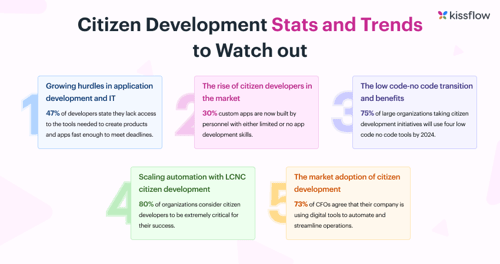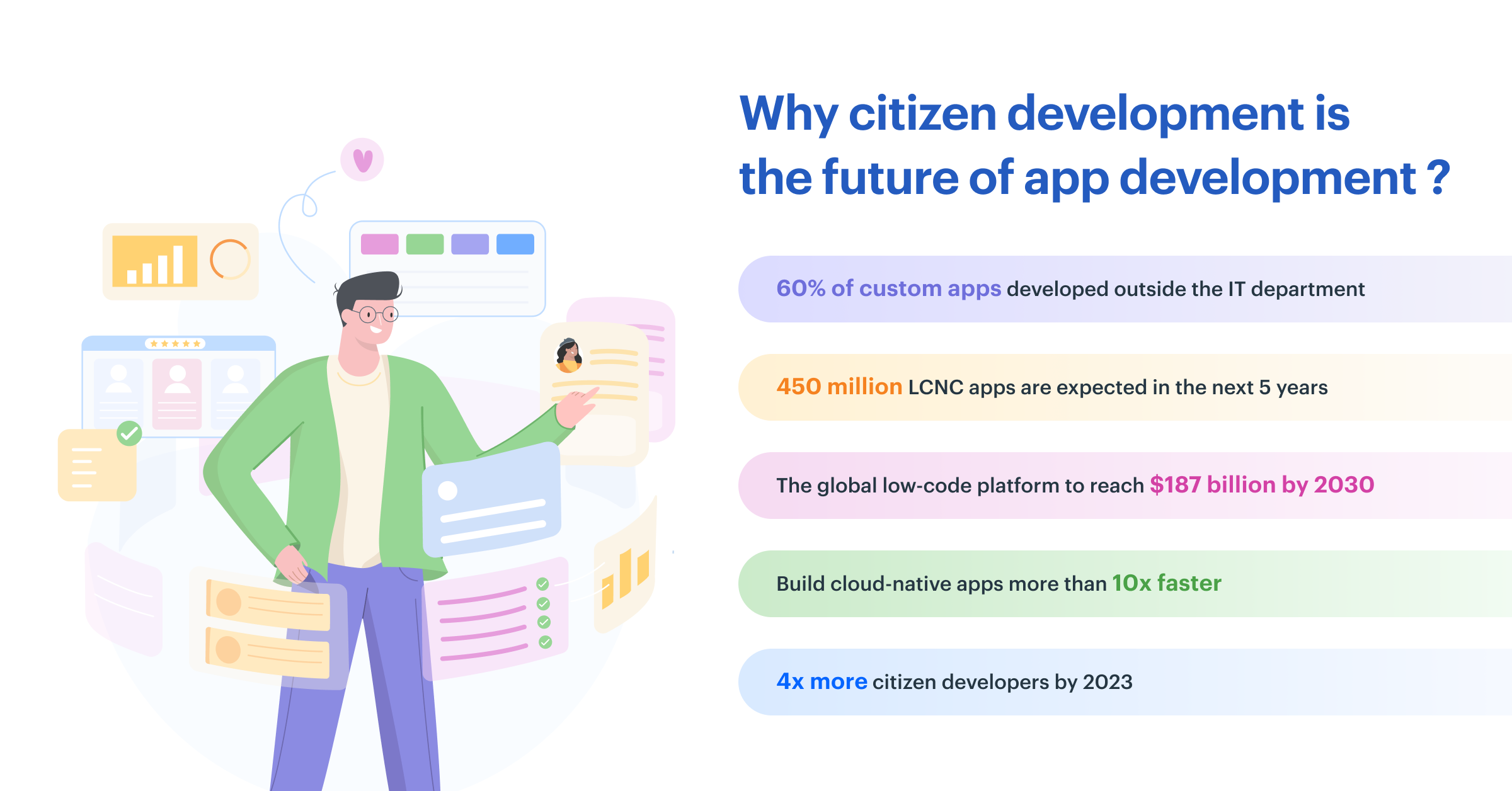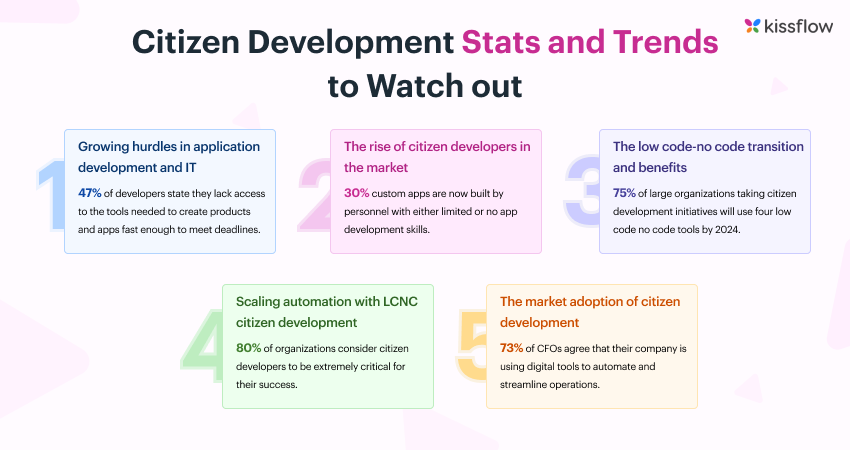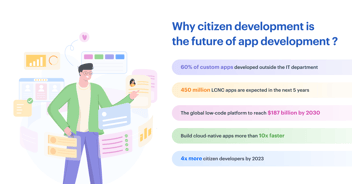
- >
- Citizen Development >
- Citizen Development Statistics and Trends to Watch in 2025 and Beyond
Citizen Development Statistics and Trends to Watch in 2025 and Beyond
Team Kissflow
Updated on 23 Apr 2025 • 6 min read
As calls for businesses to speed up their digital transformation efforts grow, citizen developers are proving to be a valuable asset. With access to low-code and no-code (LCNC) platforms, these business-side employees are creating new and innovative applications with minimal oversight from IT.
Fundamentally, citizen development is driving a culture of innovation and digital enablement that produces efficiencies throughout the organization. This blog will highlight 25 citizen development statistics and key trends that indicate its critical role in democratizing IT and scaling app development for digital transformation.
Read on to learn why citizen development is becoming popular with companies looking to stay relevant in a digital age.
A quick overview of citizen development
Before we look at the trends, let’s quickly recap the concept of citizen development.
Traditionally, if a business unit wanted an application, they’d have to speak with IT to see if they had the resources to fulfill their need. However, with companies facing a shortage of developer talent, any request was highly likely to join a queue of unfinished projects.
Fast forward to today, the proliferation of LCNC and citizen development has empowered business users to develop apps and systems on their own. These “citizen developers” are able to ship task-focused software faster than it’d take the IT department to decide on a project. Employees familiar with business processes can leverage their knowledge to create solutions that support their daily work and the organization’s overall objectives.
As a result, more and more companies are embracing citizen development than ever before. These businesses realize that citizen developers can streamline organization-wide development, and their projects can make efficiencies at both the departmental and enterprise levels.
Learn more: The Overview of citizen development

The No-Code Approach to Unlock Citizen Development Excellence
Thank you for reaching us!
Thank you for reaching us!
Why citizen development is the future?

Citizen development is a framework that allows non-IT employees to develop custom business applications with minimal or no involvement from IT. It leverages no-code or low-code platform that enable citizen developers to execute their ideas using drag-and-drop interfaces. This way, business users can help alleviate the stress on the IT department to deliver applications on time and accomplish digital transformation goals.
Citizen developers build apps in runtime environments using development methods sanctioned and approved by IT. Every citizen developer or programmer has modern tech skills and is a problem solver driven by change. The individuals capitalize on their profound knowledge of the organization’s or their department’s processes to develop efficient business apps and/or automate workflows.
Citizen development statistics and trends to watch in 2025
Citizen development is a fledgling movement that’s on track to change how startups and enterprises deploy business applications.
Below, we categorize its journey into different categories to help you understand what trends are fueling its growth and how it’s helping businesses become more agile.

1. Growing hurdles in application development and IT
In most companies, IT wants to own the entire application development process. However, critical backlogs along with a shortage of skilled workers, create hurdles in their development capacity.
For example:
- The average backlog of planned IT projects can be anywhere between 3 and 12[1]months.
- It’s estimated that the US will have a shortage of 500,000[2] software developers by 2025.
- The global shortage of software engineers may rise to 85.2 million[3] by 2030.
- The market demand for application development will increase at least 5x faster[4] than conventional IT departments can fulfill.
- 47%[5] of developers state they lack access to the tools needed to create products and apps fast enough to meet deadlines.
The rise in citizen development is eliminating these hurdles by making solution-building a collaborative effort across organizations. That is, it is helping business units and teams build applications to their own specifications with little if any, input from IT.
Further, developer shortage is being compensated through the utilization of citizen developer (aka. low code, no code) platforms, with Gartner revealing that 70%[6] of the new apps delivered by large enterprises will rely on these systems to reduce development time. In a fast-evolving business environment, speed is imperative to success.
Learn more: How Citizen Development Unites Business and IT
2. The low code-no code transition and benefits
Citizen development might not have seen daylight if no code low code platform didn’t exist. The citizen development platform allows non-developers to drag and drop features and build automation flows to reduce tedious tasks. They also offer out-of-the-box components, meaning business users don’t have to start building from scratch.
Due to these reasons, low-code no-code platforms are being increasingly adopted:
- The global low-code development platform industry is forecasted to be valued at $187 billion[7] by 2030.
- 75%[8] of large organizations taking citizen development programs will use four low code no code tools by 2025.
- 26%[9] of company executives see investment in low-code platforms as the most critical when it comes to automation.
- Of the 500 million apps to be developed over the next five years, 450 million[10] will be built using no-code low-code platforms.
- Low code no code automation can reduce the custom app development time by 50% to 90%[11]
No code low code platforms are also helping set a foundation for future citizen it developers. They enable existing users to construct and maintain a development language, which everyone inside an organization can speak to develop apps of any complexity.
3. The rise of citizen developers
Interestingly, LCNC platforms have democratized development to such an extent that anyone in the organization should be able to work on applications. This has motivated individuals with critical thinking abilities and a fundamental understanding of business needs to fabricate features, apps, or integrations by citizen integrators for the entire organization or a whole division.
There’s been an exponential growth in the number of citizen developers, with the rising tech skill shortage indicating a further increase might be on the cards:
- Large enterprises are expected to have 4x[12] more citizen developers than professional ones by 2023
- According to Gartner, by 2026, developers outside formal IT departments will account for at least 80 percent of the user base for low-code development tools.
- By 2025, 80%[13] of technology products and services will be built by non-tech professionals.
- With low code, citizen developers can brainstorm, create, test, and deploy apps 10x faster[14] than with other tactics.
- Of the custom apps built outside the IT department, 30%[15] are now built by personnel with either limited or no app development skills.
- 23% of IT automatons were built by non-IT users in business operations roles.
The rise of citizen developers has created efficiencies on various fronts, which is only natural given people who go on pursuing citizen development come from the front line and know what problems need to be solved.
Learn more: Citizen Developer Apps are the future of App Development. Here's Why
4. The market adoption of citizen development
Adoption of citizen development is growing at a breakneck pace. The idea is to get more non-technical employees involved in the development of business applications so IT can focus on more critical projects.
Along with freeing up resources, many companies are using citizen development to reduce costs and enhance transparency. The swell in the demand for apps often results in rampant unchecked product sourcing by business users—citizen development combats this by empowering users to create their own apps in an IT-approved citizen development governance.
As such, companies and their IT department are embracing citizen development with enthusiasm:
- 41%[17] of organizations are actively working with citizen developers, and 20% of those that aren’t are either evaluating or planning to start doing so.
- Citizen development integrator tools, i.e., no-code low-code tools, will reach mainstream adoption in 2-5 years.
- By 2023, 41%[18] of software developers want more than 50% of their organization’s apps to be built using low-code citizen development.
- 80%[19] of organizations consider citizen developers to be extremely critical for their success.
- Embracing citizen development can improve a company’s innovation score by 33%[20]
- 53% of business decision-makers believe the number of apps either sourced or built by non-IT business units will further rise this year
To reap the most benefits, organizations should allow citizen developers to work independently and empower them with the latest knowledge through regular training—two initiatives that can lead to higher-quality adoption within your organization.
Learn more: How To Kickstart Your Citizen Development Journey
5. Scaling automation with LCNC citizen development
So many organizations dream of scaling citizen automation, but bottlenecks like confusing processes and understaffing have traditionally prevented them from achieving this goal. Now, these companies are counting on citizen development to drive digital transformation and automation throughout the business.
Citizen developers can lend a helping hand to an organization’s Automation Center of Excellence (CoE) by automating workflows with LCNC tools.
- 26%[21] of company executives labeled no code low code tools as their most crucial automation investment, which has increased from 10% to 26% since COVID-19.
- 73%[22] of CFOs strongly agree or agree that their company is using digital tools to automate and streamline operations.
- 67%[23] of prudent organizations are more likely to implement and value code for process automation.
- 80%[24] of IT developers agree that low-code citizen development is handy for automating repetitive tasks, such as business rules and coding forms.
- 80% of organizations reveal that citizen developers have provided IT departments with more breathing space.
These stats make it clear that citizen development, driven by low code no code technology, will prove fundamental to the automation maturity of the enterprise.
Learn more: Citizen development is Fundamental to the Digital Workplace. Here's How.
Fast-track your digital transformation with citizen development
Given the trends above, it’s clear that citizen development platform will be an integral part of organizations’ digital transformation initiatives as they look to adapt to the dynamic business environment. Supported by low code no code solutions, citizen developers will shorten build times and enable businesses to align app design with user needs.
If you’re looking to empower citizen developers in your own organization, Kissflow can be a good place to start. Our solution is a low-code/no-code work platform that is designed to meet the needs of different teams in a business. Kickstart citizen development with Kissflow, boost productivity, lower costs, and accelerate your company’s digital transformation efforts.
Learn more: How citizen development facilitates digital transformation.
Sign up for Citizen Development and Shape the Future!
Related Articles











